How Russian armor fought. CH 2. Under Prasnysh and Tomashev
So, 3 German attacks in the area of the city of Prasnysh were repulsed by Russian infantrymen with the support of armored vehicles. The armored cars, breaking into the battle formations of the advancing infantry of the enemy, shot the Germans at close range.
During the retreat of the Germans from under Prasnysh, armored cars actively contributed to the development of the achieved success - not allowing the enemy to stop and recover. The document is fixed, as on the night of 13. 02. 1915, after one day breaking the 120-km distance from Starozeb (through Pułtusk) to Prasnysh, a detachment of the 1 th Auto-bullet company (4 machine-gun and cannon armored vehicles) broke into the German fortified position with. Dobrzhankovo. The 3 vehicles were shot along with the crews from the 30-meter distance, but the detachment fulfilled the most important task - by capturing the 2 bridge, cut off the Germans retreat.
As a result, the 2-th and 3-th Siberian rifle regiments (1-I Siberian Rifle Division) surrendered around the enemy infantry brigade.
The actions of the armored cars affected the course and outcome of the operation, and thousands of German soldiers landed in Russian captivity.
14. “Russo-Balty” of the 1 of the Auto-pistol Company. Disguised on the road near the town of Prasnysh. Spring 1915 Baryatinsky M., Kolomiets M. Armored cars of the Russian army 1906-1917. M., 2000.
In these victorious battles, the legend of Russian armored troops headquarters captain P. V. Gurdov was killed. The hero died a heroic death in the battle for the above with. Dobrzhankovo - helping the infantry, which could not capture the village due to the powerful artillery fire of the enemy.
War correspondent recorded details of the feat.
Gurdov rode in the front armored car, followed by lieutenant Prince Vachnadze. The cars were moving at maximum speed with the headlights extinguished. Having established the fact of the attack of the Russian armored cars, the German infantry opened fire in batches.
Ordinary and explosive bullets pierced armor - but did not stop the attack. Armored cars overcame the lines of the German trenches and reached artillery positions. The armored cars broke into the firing position of the Germans, pouring fire at the guns and rushing calculations. As a result, the gunners were killed, and the guns were disabled.
Other batteries and infantry from the nearest trenches continued shelling of armored cars - the latter were literally riddled with bullets and shrapnel. Gurdov was already hit by several bullets, but continued to fight. At this time, the Russian infantry, not restrained by the fire of the silent German battery, went on the attack and captured all the lines of the Germanic trenches. But help was late - a German shell hit the armored car of the main character of this legendary battle. At the cost of the life of heroic crews, the success of this battle was bought. Gurdov was killed, Vachnadze was seriously wounded. But, as a contemporary noted, the consequences of this unparalleled battle were enormous - it became the key to the Prasnysh victory.
For the feat in the battle of der. Dobzhankovo P.V. Gurdov posthumously awarded the Order of St. Anna 4 degree with the inscription "For Bravery", St. George weapons and promoted to captains. The body of P. V. Gurdov was delivered to Petrograd, and very soon - March 30 - an armored car was named after the fallen hero - the Packard “Captain Gurdov”.
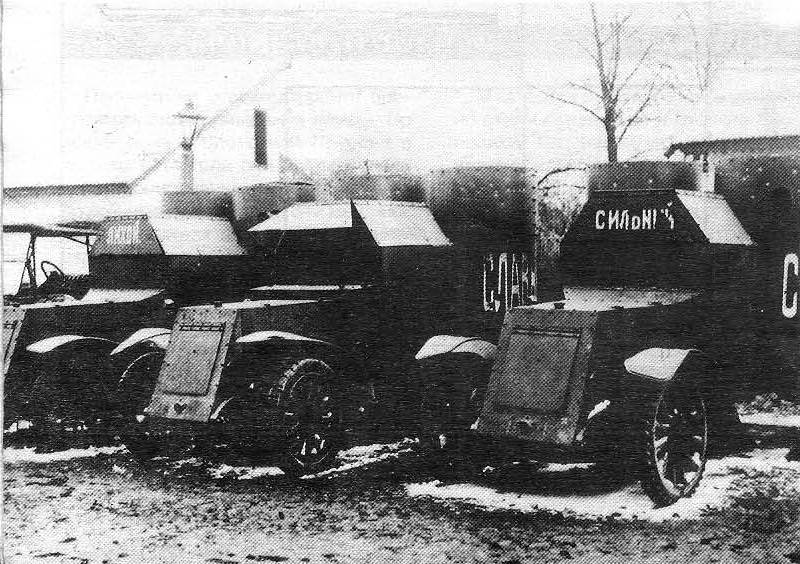
15. The armored cars of the 8 11th machine gun platoon. Lomza, February 25 1915. Armored collection. 1997. No. 1.
Armored units also showed themselves in the summer of 1915.
Thus, in the course of the defensive Tomashevskaya operation 13 - 16 on June 1915, the troops of the 3-th army and the army group of V. A. Olohova tried to stop the “Summer Strategic Cannes” of the Austro-Germans.
In these battles, the 14 autobunker platoon distinguished itself - one of the most valiant armored platoons of the Russian army. He acted independently and proactively, perfectly applying the tactics of actions from ambushes.
11 15 June platoon (2 machine gun armored "Austin" 1-th series - the British production, but the armor of Izhora plant) arrived in the city of Tomasz (Tomashev-Krasnostav highway), received the task of conducting rearguard combat: to cover the waste of Guards Volynsky regiment. The enemy’s powerful artillery did not allow the platoon to move along the highway beyond the southern outskirts of the city — and the platoon took a wait on the northern outskirts.
Around 13 hours 45 minutes autobunker platoon received an order to proceed to the implementation of the combat mission. The attempt to advance beyond the southern outskirts failed due to strong artillery fire from the Germans, and by 17 hours, once again returning to the northern outskirts of Tomashev, the platoon was in ambush - front in the direction of its outgoing units. Applying to the terrain, he prepared to cover the 3-th Guards Infantry Division and the 2-th Caucasian Army Corps, which retreated from Tomashev. In 18. 30. The first German crossing appeared. A platoon, letting his footsteps on 40, opened fire. The departure of the enemy was destroyed.
The Germans, suspending the pursuit and pulling up artillery, opened fire. Successfully and actively maneuvering under a strong artillery fire, the platoon, moving a kilometer north, again ambushed. In this position, near 20. 30. armored cars scattered the cavalry unit with accurate fire. Then the commander, deciding not to risk his cars, remaining in position at night, took a platoon to the village. Tarnovatku (Tomashev – Krasnostav highway).
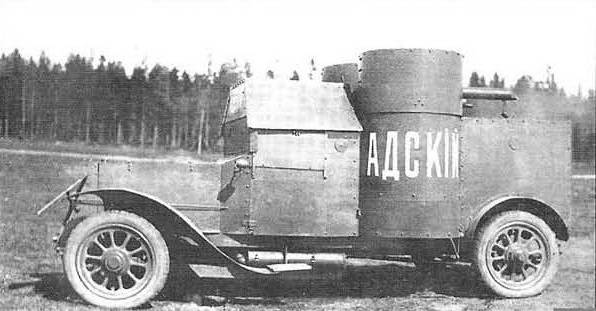
16. Armored car Austin 1-series - such machines were used under Tomashev in June 1915. Baryatinsky M., Kolomiets M. Armored cars of the Russian army 1906-1917. M., 2000.
The auto-bullet platoon distinguished itself in the battle of 16 in June north of der. Krinitsa - reapplying ambush tactics.
Taking into account the strength of enemy artillery fire, armored cars, as well as the day before, were disguised and, standing on the highway in ambush, covered the withdrawal of units of the 2 Caucasian Army Corps. Lieutenant K. Popov recalled that, moving along the highway, the Leib Erivan people passed by the 2-x armored vehicles disguised with branches. The officer noted that their presence here "was very appropriate."
At about 10 hours, the Russian infantry retreated to new positions in the rear of the armored cars. And about 13 hours before the battalion, the Germans launched an offensive from the village. Izbica - along the highway. Since the terrain at the highway had a ramp from Izbitsa, the enemy battalion was almost completely destroyed by armored car fire. The Germans opened a strong artillery fire - and the armored cars retreated to the line of their infantry, blasting their way.
Of particular interest is the tactics of Russian bronchast. In the course of the operation near Tomashev, the 14 th autobunnel platoon was given the task of detaining the enemy in the area of the highway, making it easier for his troops to withdraw: “Detaining the enemy in this direction in order to facilitate his troops to carry out the withdrawal operation”. During the rearguard battles, the platoon acted independently and proactively. Since the enemy’s firepower excluded the possibility of an attack for him, an ambush battle tactic was used. Properly assessing the situation and successfully selecting the position (at Izbitsa - at the ramp), the platoon commander fulfilled the task assigned to him. The tactical effect of the use of a platoon, its firepower and combat stability were impressive - the enemy units and units were almost completely destroyed. The diary of the platoon’s military actions contains an entry that the commander of the 204 Infantry Regiment of the Ardagan-Mikhailovsky Regiment, who interacted with the armored cars, evaluated the firepower of the platoon in the 1,25 Infantry Regiment.
In the battle of der. Krinitsy armored cars and performed the engineering task - were used to damage the road (by installing barriers).
17. Chronicles of the War 1914-15-16 No. 82.
The 14 platoon was active in the Tanev defensive operation 18. - 25. 06. 1915, during which the 3 and 4 armies of the North-Western Front, by active defense, tried to minimize the rate of advance of the Austro-German armies developing the successful Gorlitsky strategic operation.
14-th, 24-th army and 3-th Caucasian army corps of the Russian 3-th army launched an offensive, trying with active actions to facilitate the operational-tactical situation prevailing on the front of 9-th, 10-th and 15-th army corps.
The June 18 squad, supporting the 279 Infantry Regiment of the Lokhvitsky 70 Infantry Division of the 14 Corps, distinguished itself in the battle of Dembitz and Izb 18 - 20 June 1915.
A platoon received an order from the regiment commander - advancing in the direction of dd Bzhanitsa - Desert, shelling unfolding near the village of Deserts and the church of the village of Deserts of the enemy.
In this battle, armored cars attacked the enemy in reverse - at the 100-150-meter distance. The fire threw the Austrians into the woods. But the supply of water needed to cool the machine guns was used up - and the armored cars retreated to the waiting position.
Replacing water in machine guns, the platoon again rushed to the attack. This time the armored cars broke through into the enemy's position - firing on reserves of up to three battalions. The failure of one machine led to the fact that the platoon was forced to leave the battlefield.
In the situation of the predominance of Austro-German formations in artillery, the main factor that allowed armored cars to operate successfully was suddenness. A tactical break should have been taken - but the situation was forcing to act actively - and already on June 19 (the next day) the platoon supported the offensive of the 82 th Infantry Regiment of the 3 Caucasian Corps.
In this battle, the tactical situation was more difficult. For der. Izbitsa was the regimental position, and the advancing Germans were in the forest - in 600 steps. The whole road and defiles were heavily shelled by German artillery. But despite this, the platoon received the task to support the attack of the regiment, reinforced by parts of the 18-th division. The expectant platoon position was in the village. Izbitsa, and the original - in 1 km from the trenches of the 82 Infantry Regiment of the Dagestan. The action plan of the armored cars was as follows: as soon as the infantry went on the offensive, the armored cars would take turns to attack, weakening enemy fire (the Germans would hide or be distracted by the armored cars) and facilitate the advancement of the infantry.
In 17 hours 45 minutes 82 th regiment attacked, and the machines, under the fire of the German artillery, alternately forward attack also attacked the enemy. German artillery all the time hitting the highway. After six attacks, by joint efforts of armored vehicles and infantry, by the 21 hour of 45 minutes the Germans had been driven off.
Ambiguity, darkness and lack of reserves did not allow the pursuit to be developed.
Now it was necessary to send a platoon to the rear or to another sector of the front - the enemy noticed his presence, which could have disastrous consequences. But the tense situation led to the fact that the armored cars again went into battle.
20 Junior platoon was supposed to support the 70 Regiment of the 18 Infantry Division. The lack of tactical surprise had dire consequences. During the attack, one armored car was destroyed by a direct hit of a projectile; in the second vehicle, a shell hit the turret. The attack choked - the squad died, the infantry also did not move forward.
The document noted the feat of the crews of armored vehicles. Junior non-commissioned officer Skrypnik Vasily, after injuring the driver and the death of his assistant, rescuing the surviving crew members, fired a machine gun - until he died, and the armored car did not explode and burned. When the projectile snatched the front doors of the car, the corporal Antipin Sergey continued to feed the cartridges to the non-commissioned machine gunner — until a bullet hit the man’s courageous carrier of cartridges.
In the current tactical situation, the next appearance of armored cars (where it was impossible for the enemy to be unexpected) was very risky - and the 14 platoon was killed. Moreover, the platoon commander (his diary speaks about this) had a premonition. The situation required the presence of armored cars on the battlefield - to support tired and bloodless infantry - and they moved on to the attack, in fact, to certain death.
When considering these episodes of the combat use of Russian armored vehicles, it should be noted that the ambush tactics became the only correct and possible solution - in such unfavorable conditions as actions in the forest defile and under heavy shelling of artillery. It is seen and how great was the moral impact of armored cars on their troops. The battle of 20 Jun demonstrated the importance of tactical surprise for successful operations of armor.
18. Chronicles of the War 1914-15-16 No. 82.
At the beginning of July, the 1915 of the cannon compartment of the 14 of the automatic machine-gun (Garford armored car) platoon was in reserve in the area of the city of Krasnostau. After the death in the battle of Izbitsy of the machine-gun units of the platoon, it arrived in the area of the Tomashov-Krasnostav-Kholm highway, becoming part of the 14 Army Corps.
With the departure of Russian troops in early July from the positions on the river. Veprzh, the detachment was moved north of Krasnostava, joining the 3 Army Guards Corps. The armored car was given to the Life Guards regiment of the Izmailovsky His Majesty.
By the morning of July 5, the German troops occupied Krasnostav, and their positions passed along the northern edge of the city and vil. Gora. Russian units occupied the southern edge of the forest. Between the positions there was a flat glade, which the crew of the armored car had previously investigated.
By 13 hours, after a strong artillery preparation, the Germans, by far superior to the Russian forces, launched an offensive from the village of The gurs attacked the 3 Battalion of the Izmailovsky Regiment. The armored car was supposed to help repel the enemy attack - and immediately went on the attack. He reached the forefront of the Izmailovo trenches and opened fire on the chains of the advancing Germans. The chains of the enemy moved back - and the guards, going to the counterattack, threw the enemy back to the village. Gora.
The concentrated artillery fire of the enemy forced the armored car to move to a waiting position.
During the 20-minute battle, the only armored car of the Guards Corps fulfilled an important tactical task - not only by neutralizing the attack of the German infantry, but also attracted the fire of enemy artillery, which was expecting the appearance of other vehicles.
After the battle, due to the detected malfunction, the armored car was allotted to the town of Kholm for maintenance.
When the Russian troops retreated to a position south of the Savin Posad (on the Vlodawa-Kholm Highway), the armored car distinguished itself in the battle of Lysa Hora. On the night of 22 July, the Germans carried out a series of violent attacks on Russian positions south of the forest south of Savina, on the Lysaya Gora line. The main attack of the enemy was directed to the position plot adjoining Lysa Hora from the east. Garford, who was holding a wait and see position at the crossroads of the Savin - Highway, was supposed to help the infantry repel the German attack.
The armored car went out to Bald Mountain, but due to the weak moonlight (the lighting did not allow to see the targets), after standing at the position for about an hour, returned.
By the evening of July 22, the Russian units began to withdraw. Intelligence data reported that enemy cavalry was in the village near Lysa Hora. The armored car, supported by 2 Cossack hundreds, was supposed to advance to the village after the withdrawal of the Russian units and attack enemy cavalry.
At 1 on the 23 hour of July, an armored car on the highway advanced to the village and opened fire on it from the 500-meter distance. Panic broke out in the village. Having shot ammunition, Garford calmly withdrew. And intelligence then determined that under the influence of the armored vehicle’s fire, the enemy cavalry jumped out of the village, rushed back and ran into their infantry. The German infantrymen, taking their cavalry as Cossacks, opened fire on them and drove them into the swamp. Thus, the raid of the armored car had a tactical success.
The Harford armored car had a tactical effect on the situation twice during the month: under a Krasnostav, it broke the German attack, and then contributed to the success of the Izmailov counterattack, and the raid to the village. near Bald Mountain led to the fact that the enemy cavalry was knocked out of the village.
The effect of the use of armor depended on the scale of their use. So, acting in the course of the Second Prasnysh operation by groups of 5-6 vehicles, the Russian armored vehicles solved an important operational task. While supporting their infantry in the summer of 1915, the armored cars of the 14-second auto-gun platoon solved tactical tasks.
To be continued
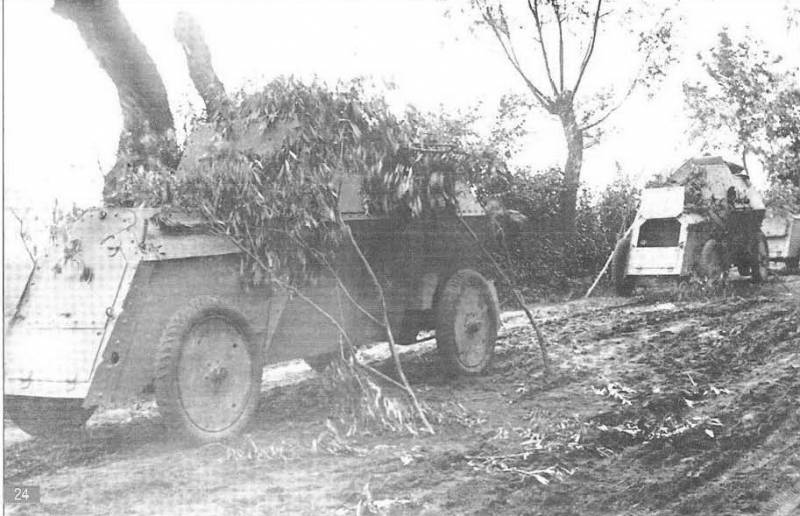
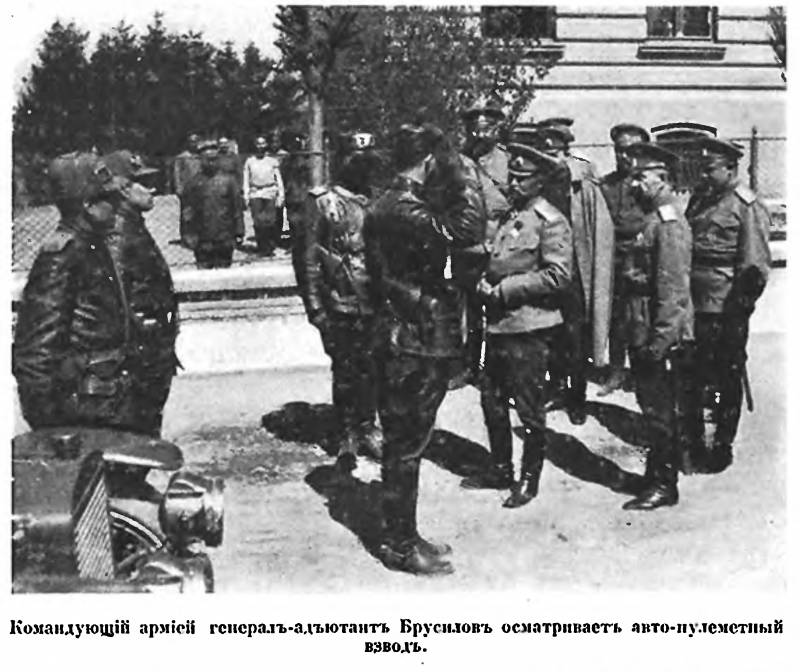
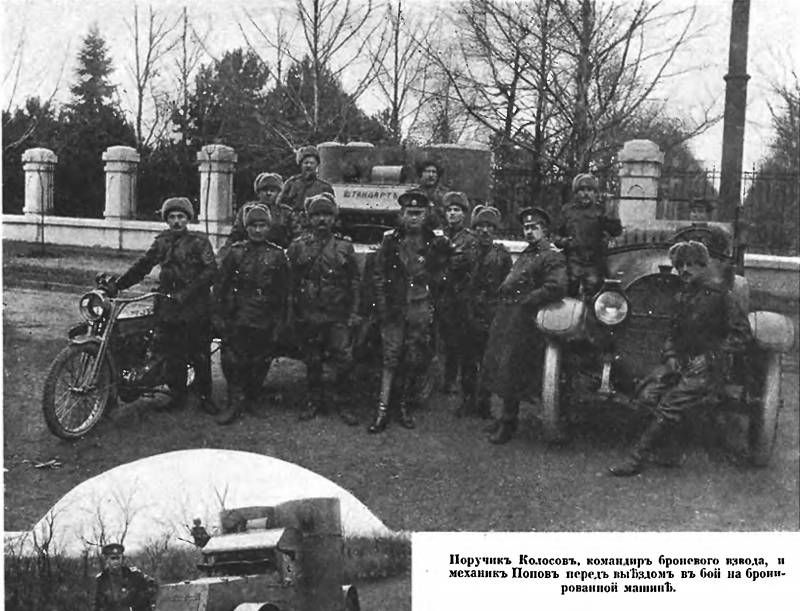
Information